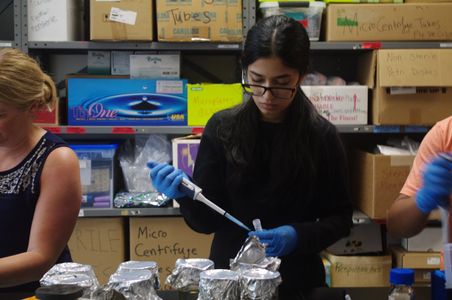CGS Expands Its Undergraduate Research Program
Ongoing research on antibiotic-resistant bacteria in Boston’s waterways is one of more than 50 undergraduate projects funded each year
By Chelsea Feinstein

The College of General Studies’ undergraduate research program has grown dramatically over the past several years. Through its Center for Interdisciplinary Teaching & Learning (CITL), CGS funds more than 55 undergraduate researchers each year—up from just one per year a decade ago—allowing students to pursue paid research as early as their freshman year.
Now, CITL is again expanding its offerings so that even more students can participate, funding for the first time a large-scale research project over the summer. Seven students are supporting Sandra Buerger, a senior lecturer in natural science and mathematics, and Robin Hulbert, a lecturer in natural science and mathematics, on a project examining antibiotic-resistant bacteria in Boston’s waterways.
“CITL is very excited to support this project, because it gives the professors the chance to work together on a mutual project and gives the students the chance to do fieldwork, bench work, library research, data analysis, and writing,” says Lynn O’Brien Hallstein, associate dean for faculty research and development at CGS, as well as the director of CITL and a professor of rhetoric. “It also gives us the opportunity to expand how CITL can support both CGS faculty and students.”
The summer research is an extension of a project that began in the spring. Each student is assigned a local body of water, accessible by the T, that they visit throughout the semester to collect water and soil samples.
Once students collect the samples, they process them in the labs. First, they dilute the water samples before dropping them on two plates—one plate has just the water sample and the second contains antibiotics. Then, they compare the presence of bacteria colonies on both types of plates. If the number of colonies is roughly even between plates, or if the number is comparatively high on the plate with antibiotics, that means the sample has a higher than expected level of antibiotic resistance.

“We’re trying to add to the body of environmental knowledge about what is happening in our water systems,” Buerger says. “It’s a small piece, but I think it’s an important piece. We have a huge rising tide of antibiotic-resistant diseases, so understanding the bigger picture of what that looks like is going to be important.”
After examining the samples, the students document their findings, creating graphs and tables and writing a summary report at the end of each semester. Buerger and Hulbert provide feedback to each student, giving guidance on how to avoid overstating their findings.
The project helps students to learn important research skills both inside and outside the lab.
“I love teaching, and I see it as an opportunity to help teach students how to do lab techniques and do a lab project,” Hulbert says.
Ye Yadana (’21, CAS’23) began working with Buerger and Hulbert during the fall 2021 semester on an earlier iteration of the project, and continued on during the spring and summer. She says the project has enabled her to make up for lab time lost during the early stages of the COVID-19 pandemic. It’s also been a valuable way for her to make contributions to important research and to build on existing connections with professors. She first heard of the research project through an announcement Hulbert made in her Biology I class.

“The research that you do with CGS professors is really meaningful because you already have an established, close relationship, and they’re very excited to help you learn,” Yadana says. “You can get this one-on-one treatment.”
Buerger and Hulbert say the hands-on nature of the project gives students skills that are rare in undergraduate research.
“When they apply to grad school, to be able to say, ‘I’ve made media, I’ve used these techniques’—that’s going to be a plus,” says Buerger.